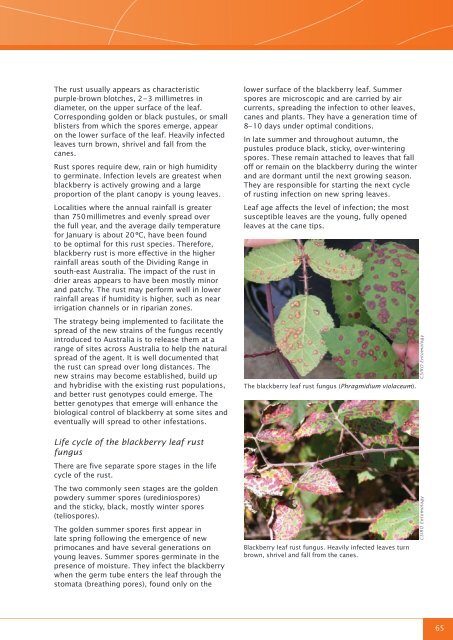Blackberry control manual - Weeds Australia
Blackberry control manual - Weeds Australia
Blackberry control manual - Weeds Australia
You also want an ePaper? Increase the reach of your titles
YUMPU automatically turns print PDFs into web optimized ePapers that Google loves.
The rust usually appears as characteristic<br />
purple‐brown blotches, 2 – 3 millimetres in<br />
diameter, on the upper surface of the leaf.<br />
Corresponding golden or black pustules, or small<br />
blisters from which the spores emerge, appear<br />
on the lower surface of the leaf. Heavily infected<br />
leaves turn brown, shrivel and fall from the<br />
canes.<br />
Rust spores require dew, rain or high humidity<br />
to germinate. Infection levels are greatest when<br />
blackberry is actively growing and a large<br />
proportion of the plant canopy is young leaves.<br />
Localities where the annual rainfall is greater<br />
than 750 millimetres and evenly spread over<br />
the full year, and the average daily temperature<br />
for January is about 20 ºC, have been found<br />
to be optimal for this rust species. Therefore,<br />
blackberry rust is more effective in the higher<br />
rainfall areas south of the Dividing Range in<br />
south-east <strong>Australia</strong>. The impact of the rust in<br />
drier areas appears to have been mostly minor<br />
and patchy. The rust may perform well in lower<br />
rainfall areas if humidity is higher, such as near<br />
irrigation channels or in riparian zones.<br />
The strategy being implemented to facilitate the<br />
spread of the new strains of the fungus recently<br />
introduced to <strong>Australia</strong> is to release them at a<br />
range of sites across <strong>Australia</strong> to help the natural<br />
spread of the agent. It is well documented that<br />
the rust can spread over long distances. The<br />
new strains may become established, build up<br />
and hybridise with the existing rust populations,<br />
and better rust genotypes could emerge. The<br />
better genotypes that emerge will enhance the<br />
biological <strong>control</strong> of blackberry at some sites and<br />
eventually will spread to other infestations.<br />
lower surface of the blackberry leaf. Summer<br />
spores are microscopic and are carried by air<br />
currents, spreading the infection to other leaves,<br />
canes and plants. They have a generation time of<br />
8– 10 days under optimal conditions.<br />
In late summer and throughout autumn, the<br />
pustules produce black, sticky, over-wintering<br />
spores. These remain attached to leaves that fall<br />
off or remain on the blackberry during the winter<br />
and are dormant until the next growing season.<br />
They are responsible for starting the next cycle<br />
of rusting infection on new spring leaves.<br />
Leaf age affects the level of infection; the most<br />
susceptible leaves are the young, fully opened<br />
leaves at the cane tips.<br />
The blackberry leaf rust fungus (Phragmidium violaceum).<br />
CSIRO Entomology<br />
Life cycle of the blackberry leaf rust<br />
fungus<br />
There are five separate spore stages in the life<br />
cycle of the rust.<br />
The two commonly seen stages are the golden<br />
powdery summer spores (urediniospores)<br />
and the sticky, black, mostly winter spores<br />
(teliospores).<br />
The golden summer spores first appear in<br />
late spring following the emergence of new<br />
primocanes and have several generations on<br />
young leaves. Summer spores germinate in the<br />
presence of moisture. They infect the blackberry<br />
when the germ tube enters the leaf through the<br />
stomata (breathing pores), found only on the<br />
<strong>Blackberry</strong> leaf rust fungus. Heavily infected leaves turn<br />
brown, shrivel and fall from the canes.<br />
CSIRO Entomology<br />
65

















